10 Belt Conveyor Types & 5 Types of Conveyor Belt Materials
Belt Conveyor PDF Download
What is Belt Conveyor

Belt conveyor is also called conveyor belt, which is a kind of transport machinery driven by friction and can transport materials in a continuous way. Belt conveyor is also an economic conveying equipment of logistics and has become an indispensable for assembly line operation.
Belt conveyor is mainly composed of 2 or more pulleys and closed conveyor belt on the tight sleeve. The pulley that drives the conveyor belt to rotate is called the driving pulley; the pulley that only changes the direction of the conveyor belt movement is called the reversing pulley or idler pulley. When working, the driving pulley is driven by the motor through the reducer, and the conveyor belt rotates by the friction between the driving pulley and the conveyor belt. Drive pulleys are usually installed at the discharge end to increase traction.
Belt conveyor system can be selected according to the process requirements: common continuous operation, beat operation, variable speed operation and other modes, and usually called “belt line, assembly line, conveyor, conveyor line”, etc. Which is widely used in coal plant, chemical industry, building materials, machinery, metallurgy, agriculture and logistics industry.
Why is Belt Conveyor Important
The wide application of belt conveyors in the market is due to its advantages in performance, which create more value for users:
Reliable Operation: In many important production units, once the machine is shut down, it will cause huge losses, and the belt conveyor can realize continuous transportation, so it is widely used.
Low Power Consumption: The conveyor belt not only reduces the running resistance, but also reduces the wear and tear of the cargo and the productivity, which is conducive to reducing the production cost.
Strong Customization: The transmission line of the belt conveyor is flexible and adaptable. The length of the line is determined according to the needs, and the maximum length can be more than 10km.
Flexible Feeding: The belt conveyor can receive materials from one or more points and discharge materials to multiple points or sections.
The simple and easy-to-use nature of the belt conveyor makes it one of the most common types of conveyor. In order to meet different needs, various types of belt conveyor are produced:
10 Hot Types of Belt Conveyor & Their Uses
- Cleated Belt Conveyor
- Inclined Belt Conveyor
- Flat Belt Conveyor
- Trough Belt Conveyor
- Roller Bed Belt Conveyor
- Portable Belt Conveyor
- Retractable Belt Conveyor
- Curved Belt Conveyor
- Steel Belt Conveyor
- Special Belt Conveyor
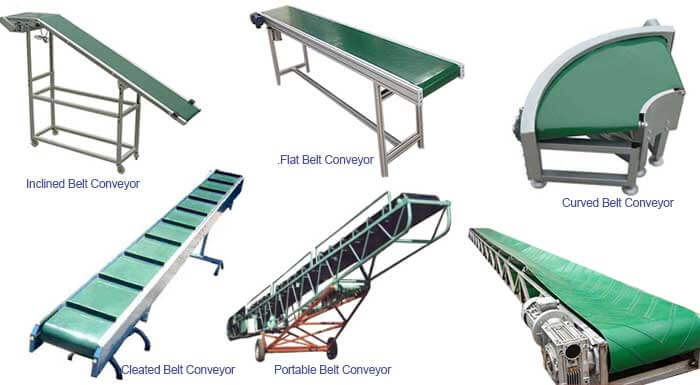
1. Cleated Belt Conveyor
The vertical cleats are distributed along the width of the belt in the cleated belt conveyor. The function of cleats are to support the material and realize the large angle transportation.
Cleated belt conveyor is widely used in coal, grain, building materials, chemical industry, hydropower and metallurgy industries. In the range of – 19 ℃ – + 40 ℃, it transports all kinds of easily scattered powder, granular, small block, paste and liquid materials with a stacking proportion of 0.5-2.5 t/m³.
2. Inclined Belt Conveyor
When materials need to be raised or lowered, it is often necessary to use inclined belt conveyors, but there is a certain limit to the tilt. Generally, the tilt up angle is not more than 18 °.
3. Flat Belt Conveyor
Flat belt conveyor has the general structure and characteristics of the belt conveyor, which is suitable for the transportation of irregular shape and light weight objects, such as postal parcels, clothes, paper products, plastic products, etc
The flat belt conveyor is divided into built-in motor type, head drive type and middle drive type.
4. Trough Belt Conveyor
Trough belt conveyor has a large loading and conveying capacity, the conveyor belt of the trough belt conveyor adopts multi-layer rubber belt, with the belt width of 500mm, 650mm, 800mm, 1000mm, 1200mm and 1400mm. The carrying side conveyopr belt is supported by a troughed idler that composed of 3 rollers (the angle of the trough can reach 45°), and the return idlers are supported by flat rollers.
Trough belt conveyors are widely used in electric power, iron and steel, mining, port, cement, grain, feed processing industry. Trough belt conveyors can transport bulk materials with large proportion such as coal, ore, soil, chemical raw materials, grain, etc., which are more suitable for a relatively poor production environment.
5. Roller Bed Belt Conveyor
Roller bed belt conveyor is a kind of conveyor which uses several rollers which are set up on the fixed support according to a certain distance to transport goods. Roller bed belt conveyor is suitable for all kinds of boxes, bags, pallets and other pieces of cargo transportation, mostly used for station or airport luggage sorting.
Roller bed belt conveyor can be used alone or in combination with other conveyors or working machines on the assembly line. It has the advantages of simple structure, reliable operation, flexible line layout, etc. According to whether the roller has driving device or not, the roller bed belt conveyor can be divided into two types: unpowered type and power type.
6. Portable Belt Conveyor
Universal wheels are installed at the bottom of the portable belt conveyor, which can move freely according to the stacking position of the materials, and are mostly used in the environment with small conveying inclination angle.
Portable belt conveyor is mainly used in places where loading and unloading places change frequently, such as ports, wharves, stations, coal plant, warehouses, construction sites, sand and stone plant, farms, etc., for short-distance transportation and loading and unloading of bulk materials or single weight of less than 100 kg of finished goods.
7. Retractable Belt Conveyor
The frame of the retractable belt conveyor is equipped with a storage belt device, which can make the belt stretch freely in the length direction and adjust the conveyor length according to the change of the belt working position at any time.
Retractable belt conveyor is the most efficient and commonly used machine in the continuous conveying of materials. It is the main equipment of coal conveying system in coal preparation plant and power plants.
8. Curved Belt Conveyor
Generally, the belt conveyor can only run in a straight line on a horizontal or vertical plane. To bypass obstacles or unfavorable sections, an intermediate transfer station needs to be set up, which has a high engineering cost. Curved belt conveyor realizes the natural curves of the conveyor by changing the arrangement angle of the idler group, reduces the transfer station numbers, and solves a series of problems brought by the transfer station.
Curved belt conveyor has been widely used in mining, metallurgy, chemical industry, power station and ports, especially for long-distance transportation.
9. Steel Belt Conveyor
Steel belt conveyor uses stainless steel belt instead of belt. For the belt conveyor will release harmful substances when conveying materials with high temperature, while the steel belt will not, steel belt conveyor is more suitable for material conveying in the food industry.
10. Special Belt Conveyor
Special belt conveyor is designed separately for the transportation of goods under special circumstances, which has a small range of applicability. Some of these are: magnetic belt conveyor, narrow belt conveyor, acid and alkali resistant belt conveyor, flame retardant belt conveyor, etc.
5 Types of Conveyor Belt Materials & Their Applications
Although many times peoples called a belt type conveyor as “Conveyor Belt“. But in fact the conveyor belt just refers to the materials of belts. Below will introduce some common types of conveyor belt materials and their applications:
1. PVC Conveyor Belt

PVC conveyor belt
PVC conveyor belt is a white or light colored, pollution-free conveyor belt made of high strength and quality cotton, nylon, polyester canvas as the belt core and combined with natural PVC.
PVC conveyor belt features good elasticity, not easy to deform and wear-resistant. It is mainly used in food, tobacco, logistics, packaging and other industries. At the same time, it is suitable for underground transportation of coal mines, as well as material transportation of metallurgy and chemical industries.
2. PU Conveyor Belt
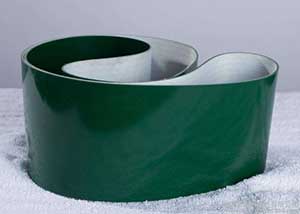
PU conveyor belt
Polyurethane (PU) conveyor belt, with strong tear resistance, good elasticity, certain impact resistance, can be used normally under complex conditions, but also has good water resistance, can be used normally even in cold and humid conditions, without any impact on the conveyor belt.
PU conveyor belts are widely used in the food industry or grain sector to transport bulk, canned, and packaged grains, biscuits, candies, fruit and vegetable processing, poultry and meat processing, and other related industries. Polyester conveyor belt price is relatively high, but in the long run, polyester conveyor belt will be more economic.
3. PE Conveyor Belt

PE conveyor belt
PE is the abbreviation for polyethylene, which is the simplest polymer organic compound in structure. It is the most widely used polymer material in the world today. It is polymerized from ethylene and divided into high-density polyethylene, medium density polyethylene, and low-density polyethylene according to different densities.
PE conveyor belt has high tensile strength, good flexibility, light, thin, tough, oil resistant, non-toxic, hygienic and easy to clean. PE conveyor belt conforms to the American FDA health standards, can be in direct contact with food, medicine, etc., and is a durable conveyor product.
4. Plastic Interlocking Belt
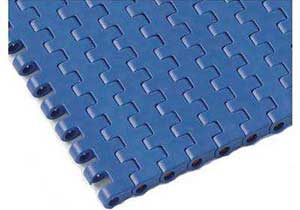
Plastic interlocking belts
Plastic interlocking belts refer to the conveyor belt which is molded by plastic Thermoplastics into a single plate semi-finished product module, then repeatedly assembled into a chain type by the module, and installed on the conveyor to carry and transport materials.
Plastic interlocking belt is a new type of conveyor belt, which has many advantages over the traditional conveyor belt: high strength, acid resistance, alkali resistance and salt water, wide temperature range, good anti viscosity, can be added with cleats, large lifting angle, easy cleaning, simple maintenance, and can be used for transportation in various environments.
5. Metal Conveyor Belt
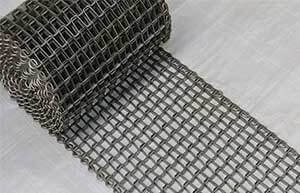
Stainless steel conveyor belt
According to different weaving methods, metal conveyor belt can be divided into different types, such as diamond mesh belt, trapezoid metal mesh belt, ball mesh belt, u-chain mesh belt. The material of metal conveyor belt can also be used according to different requirements: stainless steel wire, carbon steel wire, polyester wire and galvanized wire, etc.
Metal conveyor belt is characterized by high temperature resistance, wear resistance, corrosion resistance, high tensile strength and long service life. Stainless steel conveyor belt is the most widely used among the metal conveyor belts, which is widely used in stainless steel tableware annealing, glass products, machinery, powder metallurgy, etc.
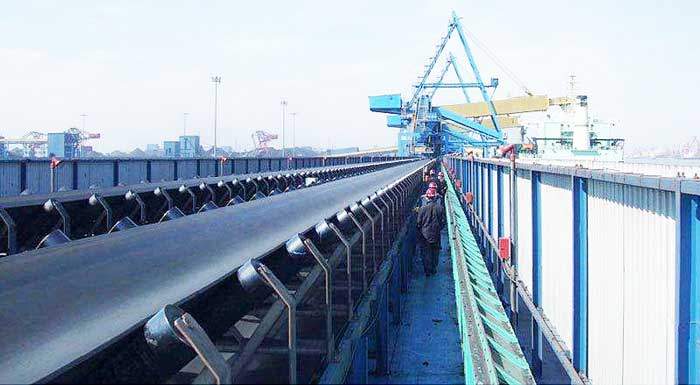 16 Methods Help To Solve Belt Conveyor Deviation Problem
16 Methods Help To Solve Belt Conveyor Deviation Problem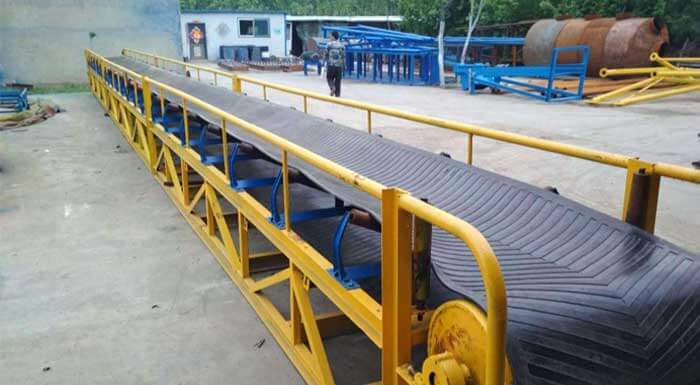 Hot 10 Types of Belt Conveyor Troubleshootings
Hot 10 Types of Belt Conveyor Troubleshootings Conveyor Belt Working Principle & Application
Conveyor Belt Working Principle & Application 10+ Tips Help To Select A Right Conveyor Belt
10+ Tips Help To Select A Right Conveyor Belt


Nice day!
We are main manufacturer of Non-Slip Rubber Sheeting,
Common Rubber Sheeting and Conveyor belts, our production time is 20 days, do you have inquiry for conveyor belts price?
Thanks and Regards,
coco
Fleat conveyor Materials purchase
I appreciate it when you explained that the driving pulley is what is used for the conveyor belt to rotate while also changing the direction with the reverse options. It seems that there are different types of belt police to be used in various production processes. And I can imagine how important it is to get the right tools and materials for your company depending on what product you are creating in order to prevent damage and delays in the process.
i need convoyer belt for plastic product… so which belt suitebal for us PVC or pu for long time.
good day
i am looking for a strong and durable portable conveyor belt which can offload 50kg from train wagons to warehouse or wagon to truck. at how much can i get it . i need an industrial type to use in a big organisation.
regards
kismet
Dear kismet kombo,
Thanks for your inquiry, i have asked the supplier to reply you very soon.